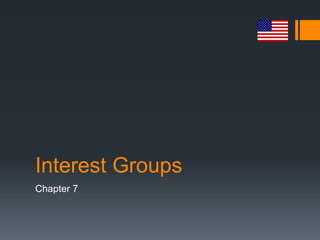
Govt 2305-Ch_7
- 2. What Are Interest Groups Interest Groups – An organized group of individuals sharing common objectives who actively attempt to influence policymakers Influence without governance Influence without responsibility Interest groups are often spawned by social movements A movement that represents the demands of a large segment of the public for political, economic, or social change
- 3. What Are Interest Groups Public vs. Private Interests Private Interests Examples: National Association of Manufacturers, Amateur Radio Relay League, American Farm Bureau Federation Public Interests Examples: American League to Abolish Capital Punishment, National Child Labor Committee
- 4. Why Are Interest Groups Important? A reason to be concerned: Deleterious effects on democracy Interest Groups act as unelected elites Interest Groups act as factions Madison, Federalist #10 – “The latent cause of faction are thus sown into the nature of man” “the regulation of these various and interfering interests [is] the principle task of modern legislation”
- 5. What Do Interest Groups Do? Attempt to Influence Elections Endorsements Rate Candidates Give money through Political Action Committees Attempt to bring people to the polls (the Christian Coalition in the 1980s)
- 6. What Do Interest Groups Do? Lobby (attempt to influence policy) Distributive lobbying (a.k.a. “pork”) Iron triangles Revolving-door hypothesis Regulators with prior employment in the industry they are regulating (FCC) Informational lobbying Issue networks Revolving-door hypothesis Interest groups are best informed about policy
- 7. Where Do Interest Groups Come From? Why are there Interest Groups at all? Collective action; the free-rider problem The difficulty interest groups face in recruiting members when the benefits they achieve can be gained without joining the group Ex. AARP and senior citizens’ groups Interest Groups can be crippling Business and industry associations were long plagued by free-riding off of pro-business lobbying Easy to think about lots of potential groups that do not exist at all because of this problem
- 8. Where Do Interest Groups Come From? Reasons for Interest Group Formation Disturbance Theory Interest groups form and grow in response to perceived threats (NRA grew as a result of the Brady Bill) Groups form in response to opposition groups (Handgun Control, Inc. vs. NRA) Entrepreneurship; patrons and financiers People who have money, time, and an agenda “for the public interest” Best interests of the overall community; the national good rather than the narrow interests of a particular group
- 9. Where Do Interest Groups Come From? Reasons for Interest Group Formation Selective Benefits Solidary Incentives – reason/motive that flows from the desire to associate with others and to share with others a particular interest or hobby (ARRL) Material Incentives – reason/motive based on the desire to enjoy certain economic benefits or opportunities (AARP) Purposive Incentives – reason for supporting/participating in the activities of a group based on agreement with the goals of the group Someone who really cares about environmental conservation might join the Sierra Club
- 10. Interest Group Lobbying Lobbyist An organization/individual who attempts to influence legislation and the administrative decisions of the government Interest group lobbying attempt to influence legislation through: Direct Techniques – interest group activity that involves interaction with government officials to further the group’s goals
- 11. Interest Group Lobbying Interest group lobbying attempt to influence legislation through: Indirect Techniques – strategy employed by interest groups that uses third parties to influence government officials Also use climate control to improve an industry’s public image Use of public relations techniques to create favorable public opinions toward an interest group, industry, or corporation Boycotting is another unconventional form of pressure typically used against those who oppose an interest group’s goals Form of pressure or protest – an organized refusal to purchase a particular product or deal with a particular business Could the American Revolutionaries be considered an interest group?
- 12. Problems With Interest Groups Bias and organizational politics Do labor unions and their PACs really represent workers and the Labor Movement? Economic and political expression of working-class interests; politically, the organization of working-class interests Does the NRA really represent gun owners, or gun makers? Upper-class Bias Those with more resources ($$) join interest groups Business and professional groups more numerous and better financed (American Medical Association, American Association for Justice)